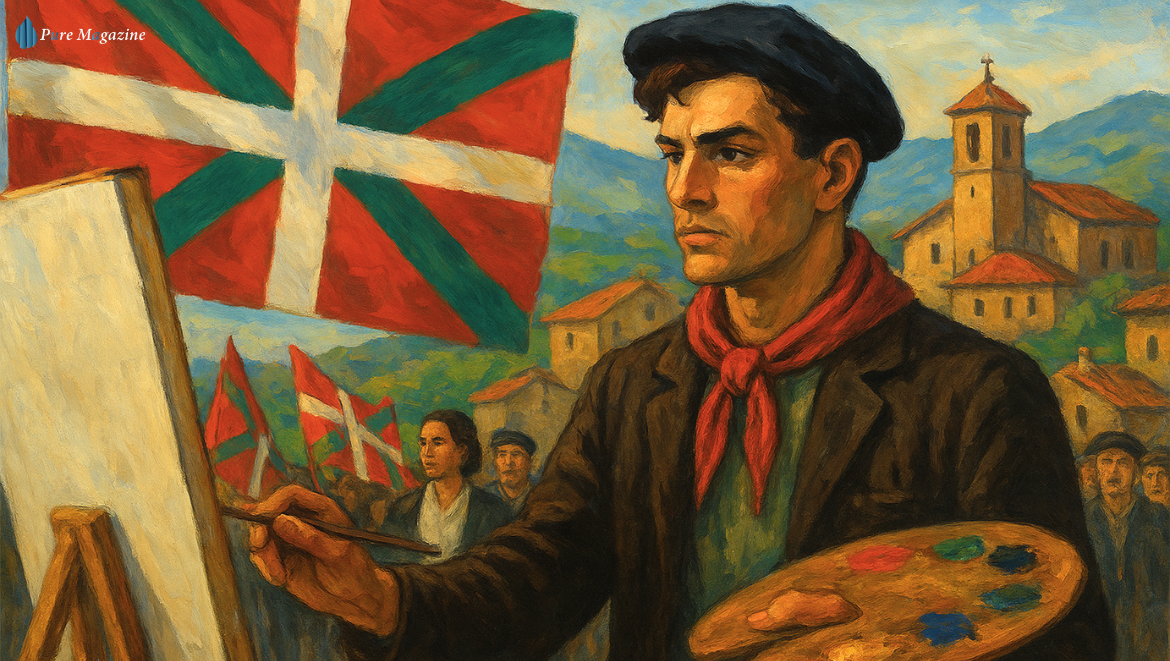Basqueserpartists. Say it out loud. Feels odd on the tongue, doesn’t it? Looks like someone mashed two words together and forgot to clean up the mess. And in a way, that’s exactly what it is.
It’s shorthand for a mix of things: Basque separatists, Basque artists, Basque activists. People who lived in a part of Europe that has always felt a little apart from Spain, a little apart from France, and who refused to let their culture get swallowed. Some fought with weapons, some with paint, some with words. But all of them carried the same torch: Basque identity.
The Basques: Old People, Old Language, Old Pride
The Basque Country isn’t big on maps. Tucked between northern Spain and southwestern France, it’s the kind of place outsiders sometimes drive through without realizing they’ve crossed into a whole different world.
But the Basques are not like anyone else. Their language, Euskara, is older than Latin. No one knows where it came from. Think about that: in a Europe where most tongues trace back to the Romans, the Basques were already telling stories in a language nobody could place.
Add to that a food culture (ever had pintxos?), folk sports like pelota, and an unshakable pride that borders on stubbornness—and you start to see why Basque identity is more than just heritage. It’s survival.
When Culture Becomes a Fight
The 20th century was brutal for the Basques. Franco’s Spain (1939–1975) banned Euskara in schools and public life. Imagine being told your own mother tongue was illegal. For many families, it wasn’t just humiliating—it was erasure.
That’s where the idea of “Basqueserpartists” comes in. Some turned to politics, some to resistance, some to art. All carried pieces of the same mission: keep the culture alive, whatever it takes.
ETA: The Chapter Nobody Can Skip
You can’t sugarcoat it. Talking about Basqueserpartists means talking about ETA (Euskadi Ta Askatasuna).
ETA started in 1959 with a vision of independence. At first, it was mostly activism, but then came bombs, assassinations, and kidnappings. Decades of violence. For a lot of Spaniards, the word “Basque” became tied to fear.
But that’s only half the story. The Spanish government didn’t stay clean either. There were torture cases. Illegal anti-terrorist groups like GAL ran their own “dirty war.” Doctors like Esteban Muruetagoiena died after being interrogated. Families were torn apart.
And here’s the real kicker: most of the world only ever heard the simple version. ETA = terrorists. Spain = victims. Reality was far messier. Writers like Edurne Portela and voices like Tamara Muruetagoiena have spent years digging through the silence, trying to remind people of the “little nuances” that got lost.
When Art Picks Up the Work Guns Left Behind
Not everyone wanted blood. Many Basques realized something: if politics got censored, art could slip through the cracks.
Take sculpture. Eduardo Chillida’s Peine del Viento (The Comb of the Wind) isn’t just steel by the sea—it’s resistance in plain sight. Or look at murals in Bilbao: not just decoration, but coded language, a shout written in color.
Music, too. Songs in Euskara carried weight when speeches couldn’t. Books preserved memory when official records denied it. Even street graffiti told stories politicians wanted erased.
In short, art became a weapon that didn’t kill, but kept people alive.
Today’s Basqueserpartists: A Different Kind of Rebel
Fast-forward. ETA dissolved in 2018. Guns quieted down. But the cultural fight? Still there. It just looks different.
Now it’s filmmakers putting Euskara on screen. Chefs like those in San Sebastián (home to more Michelin stars per square meter than anywhere else on earth) are putting Basque food in global headlines. Teenagers remixing folk songs into electronic beats.
The battlefield has shifted—from mountain hideouts to TikTok feeds. And yet, the goal is the same: don’t let Basque identity fade.
Memory as Armor
Here’s the thing about trauma: if you don’t talk about it, it doesn’t disappear. It just gets heavier.
That’s why so many Basqueserpartists focus on testimony and memory. Portela’s writing. Tamara Muruetagoiena’s public speaking. NPR archives, oral history projects, family stories whispered in kitchens.
They’re not just retelling the past. They’re defending the right to be remembered properly, without censorship, without spin.
Beyond the Homeland
And then there’s the diaspora. Basques didn’t all stay in Spain and France. Waves of them moved to Argentina, Chile, and the United States.
Ever been to Boise, Idaho? Sounds random, but it’s home to one of the largest Basque communities in the U.S. They throw festivals with dancing, cider, and accordion music that would make you swear you were back in Bilbao.
That’s the power of cultural roots—they travel. Basqueserpartists abroad act like cultural ambassadors, keeping the spirit alive thousands of miles from home.
Peace, But Not Closure
Spain likes to say the Basque conflict is “over.” Maybe politically, sure. But socially? Not so clean.
The far right still pushes back against autonomy. Families of ETA’s victims demand justice. Families of tortured Basques demand acknowledgment. Everyone has scars, and not everyone agrees on how to heal.
This is the uncomfortable truth: peace doesn’t mean the end of division. It just means you live with it, hoping future generations handle it better.
Why the World Should Care
At first glance, you might think this is all too local. Why should someone in New York, Karachi, or Sydney care about Basqueserpartists?
Because their story is bigger than geography. It’s about how a small people held onto identity in the face of erasure. How art stood in for politics when politics failed. How memory became the only way forward when justice lagged.
In a world where cultures disappear overnight, that lesson matters.
Final Thoughts
Basqueserpartists aren’t a neat category. They’re messy, like the history they come from. Some picked up guns, others picked up guitars, and many simply kept speaking Euskara when it was forbidden.
But together, they made sure one thing stayed true: the Basque story never went silent.
And maybe that’s the simplest way to understand them. They’re proof that identity isn’t handed down by governments or written only in law. It’s carried in art, in memory, in the stubborn choice to keep speaking, singing, and creating—even when the world tells you not to.
Visit: Pure Magazine








